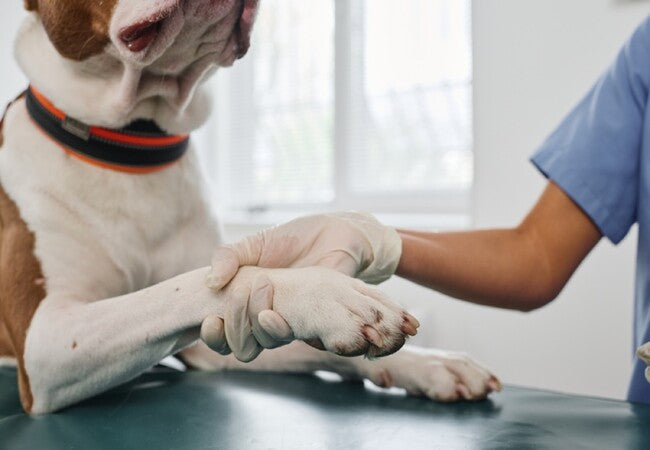Tumors on Dog Paws in 2025 Vet Guide: Spotting, Diagnosing & Treating Growths 🐾🦶

In this article
Tumors on Dog Paws in 2025 Vet Guide: Spotting, Diagnosing & Treating Growths 🐾🦶
By Dr. Duncan Houston BVSc
Hello, devoted pet parents! I’m Dr Duncan Houston BVSc. In this 2025 guide, we're focusing on a less‑discussed but important issue—tumors that grow on your dog’s paws. Although they may seem minor, growths on toes, paw pads, or nails can cause discomfort or even be cancerous. We'll explore common types, signs, diagnostic steps, treatment options—including surgery and amputation—prognosis, recovery, and how Ask A Vet can support you every step of the way ❤️.
1. Why Paw Tumors Matter
Tumors appearing on paws differ from skin lumps elsewhere. They can affect mobility, cause pain, bleed easily, and may involve bone or nail beds. Prompt attention is crucial as malignancies—though not the most common—can arise in areas like toes, pads, or surrounding tissue.
2. Common Types of Paw Tumors
Paw tumors range from benign to malignant. Here's an overview:
a) Benign Growths
- Histiocytoma: Button-like, common in young dogs, often regress spontaneously.
- Plasma cell tumors: Small, localized growths; may require excision.
- Basal cell tumors: Dome-shaped, may ulcerate, but typically not cancerous.
b) Malignant Tumors
- Melanoma: Often pigmented, aggressive, and prone to metastasis—can occur near toenails.
- Squamous cell carcinoma (SCC): Ulcerated, crusty; may invade tissue and spread.
- Fibrosarcoma & soft tissue sarcomas: Deep-seated, firm, with potential bone involvement.
- Mast cell tumor: “The great pretender”—may appear as an irritated lump on the paw.
- Osteosarcoma & bone-origin tumors: Arise from toe bones, may cause swelling and lameness.
- Hemangiosarcoma: Rare vascular cancer; may present as blood-filled, bleeding growths.
3. Signs & Symptoms to Watch
- New lump on paw, toe, nail bed, or pad.
- Limping or favoring one paw.
- Persistent licking or chewing at the site.
- Bleeding, ulceration, or nail abnormalities.
- Swelling near lymph nodes (popliteal, inguinal) or respiratory signs if metastasis is suspected.
4. Diagnostic Protocol 🔍
Your veterinarian will likely proceed as follows:
- History & Exam: When and how fast the mass grew, and changes in nail or pad.
- Imaging: X-rays to assess bone involvement, chest and abdominal imaging to screen metastasis.
- Sampling: Fine-needle aspiration (FNA) and cytology; biopsy for definitive diagnosis.
- Pathology: Determines tumor type, grade, and invasion depth—key for prognosis and treatment decisions.
5. Treatment Strategies in 2025
a) Surgery
- Local excision: Effective for small benign tumors with clean margins.
- Toe amputation: Common for malignant or bone-invasive tumors (like melanoma or osteosarcoma); offers excellent control and often full recovery.
b) Radiation Therapy
Used for tumors near bones or with incomplete surgical margins; good option if amputation is not possible.
c) Chemotherapy & Targeted Treatment
- Mast cell tumors: May require chemo, antihistamines, or tyrosine kinase inhibitors after removal.
- Oral melanoma vaccine: Occasionally used post-surgery for digital melanoma to reduce recurrence.
d) Palliative Care
For inoperable tumors: pain control, infection management, protect pad integrity.
6. Prognosis & Long-Term Outlook
- Benign tumors: Excellent outcome with surgical removal.
- Malignant tumors: Prognosis depends on type and stage. Early removal of melanoma or SCC can be curative; osteosarcoma and soft tissue sarcomas have greater risk of metastasis.
- Mast cell tumors: Variable; low-grade tumors can be controlled, while high-grade ones may spread, requiring multimodal therapy.
7. Recovery & Home Care 🏡
- Post-op pain relief (NSAIDs, opioids).
- Keep bandages clean and follow draining care instructions.
- Restricted activity to allow healing.
- Regular wound checks and suture removal.
- Physical therapy post-amputation to promote smooth gait.
8. Prevention & Vigilance 🔎
- Check paws weekly for lumps, bleeding, nail issues.
- Investigate any new growth, persistent sore, or nail discoloration promptly.
- Mastitis occurs even in spayed dogs—don't ignore changes.
9. How Ask A Vet
- Ask A Vet: 24/7 help evaluating paw masses, deciding when to see the vet, guiding post-op wound care, and flagging complications.
10. Emotional & Community Support ❤️
Finding a lump can be scary. Ask A Vet offers reassurance throughout diagnosis and recovery. lighten care burdens, so you can focus on cuddles and healing. Community forums connect you with others who've walked similar paths—you're not alone on this journey 🐶.
11. Final Thoughts
Paw tumors in dogs may look small, but they can cause serious pain or be malignant. A "wait-and-see" approach risks worse outcomes. Early vet visits, precise diagnosis, appropriate treatment—especially when malignant—mean the best chance for full recovery. Combined with care from Ask A Vet, you're giving your pup the best possible treatment path and emotional support 🌟.
— Dr Duncan Houston BVSc
For continued guidance and care tools, visit AskAVet.com and download the Ask A Vet app now!






